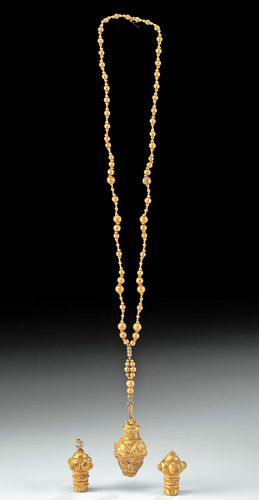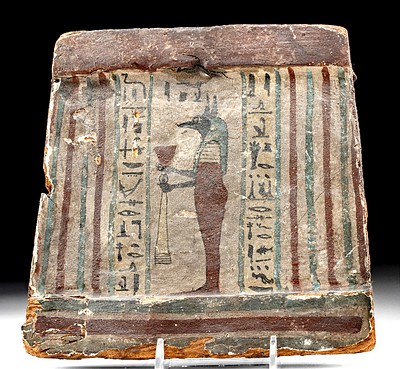Stunning Achaemenid Persian Gold Necklace & Earrings
Lot 23d
About Seller
Artemis Gallery
686 S Taylor Ave, Ste 106
Louisville, CO 80027
United States
Selling antiquities, ancient and ethnographic art online since 1993, Artemis Gallery specializes in Classical Antiquities (Egyptian, Greek, Roman, Near Eastern), Asian, Pre-Columbian, African / Tribal / Oceanographic art. Our extensive inventory includes pottery, stone, metal, wood, glass and textil...Read more
Categories
Estimate:
$28,000 - $42,000
Absentee vs Live bid
Two ways to bid:
- Leave a max absentee bid and the platform will bid on your behalf up to your maximum bid during the live auction.
- Bid live during the auction and your bids will be submitted real-time to the auctioneer.
Bid Increments
| Price | Bid Increment |
|---|---|
| $0 | $25 |
| $300 | $50 |
| $1,000 | $100 |
| $2,000 | $250 |
| $5,000 | $500 |
| $10,000 | $1,000 |
| $20,000 | $2,500 |
| $50,000 | $5,000 |
| $100,000 | $10,000 |
| $200,000 | $20,000 |
About Auction
By Artemis Gallery
Aug 26, 2021
Set Reminder
2021-08-26 10:00:00
2021-08-26 10:00:00
America/New_York
Bidsquare
Bidsquare : Fine Antiquities | Asian | Ethnographic Art
https://www.bidsquare.com/auctions/artemis-gallery/fine-antiquities-asian-ethnographic-art-7366
Features classical antiquities, ancient and ethnographic art from cultures encompassing the globe. Egyptian, Greek, Roman, Etruscan, Near Eastern, Asian, Pre-Columbian, Native American, African / Tribal, Oceanic, Spanish Colonial, Russian, Fine / Visual Arts, so much more! Artemis Gallery info@artemisgallery.com
Features classical antiquities, ancient and ethnographic art from cultures encompassing the globe. Egyptian, Greek, Roman, Etruscan, Near Eastern, Asian, Pre-Columbian, Native American, African / Tribal, Oceanic, Spanish Colonial, Russian, Fine / Visual Arts, so much more! Artemis Gallery info@artemisgallery.com
- Lot Description
Ancient Near East, Achaemenid Persian Empire, ca. 400 BCE. A breathtaking necklace and earrings composed of 64% to 90% gold, equivalent to 15K+ to 21K+. The attention to detail and craftmanship on each piece is astounding. The necklace is strung with over 60 petite spherical beads with filigree embellishments encircling each bead; imagine the skill of the artisan to cover each minute surface with such delicate swirls! Between the spheres are petite seed beads that balance the strand and add symmetry. The strands come together as one and then threaded through the twisted link that connects a stunning pendant. The pendant is a sizable sheet of gold that is shaped to form a hollow, piriform body that resembles a jar. Across the surface of the carinated body are registers of granulated triangles and spirals interspersed with clusters of granulations that form intricate geometric patterns. The top of the pendant contains four larger granulated balls around the terminal loop. The earrings are an intriguing arrangement: a cylindrical shape with five rows of granulated balls and triangular clusters that supports a rounded top with granulated nodules protruding from the sides. One earring is surmounted with a glass bead on a wire finding that perhaps attached to an ear hook at one time. The entire composition of gold filigree and granulation on each piece is stunning and a priceless piece of ancient artistry! Size of necklace strand doubled: 12" L (30.5 cm); pendant: 2.15" L x 1.2" W (5.5 cm x 3 cm); earring: 1.8" L x 0.75" W (4.6 cm x 1.9 cm); quality of gold: 64.4% to 90.8% (equivalent to 15K+ to 21K+); total weight of all: 52.9 grams
The Achaemenid love of silver and gold was famous throughout the ancient world. Plato wrote of how the acquisition of gold and silver was considered a virtue while Alcibiades, another Athenian, wrote of the enormous wealth in gold and silver that the Persians had. In a society where the elite displayed their wealth via such baubles, these earrings, beads, and pendant, would have been prized possessions, demonstrating the high social status of their wearer!
This piece has been searched against the Art Loss Register database and has been cleared. The Art Loss Register maintains the world’s largest database of stolen art, collectibles, and antiques.
Provenance: private California, USA collection, purchased in Iran in the 1960s
All items legal to buy/sell under U.S. Statute covering cultural patrimony Code 2600, CHAPTER 14, and are guaranteed to be as described or your money back.
A Certificate of Authenticity will accompany all winning bids.
PLEASE NOTE: Due to recent increases of shipments being seized by Australian & German customs (even for items with pre-UNESCO provenance), we will no longer ship most antiquities and ancient Chinese art to Australia & Germany. For categories of items that are acceptable to ship to Australia or Germany, please contact us directly or work with your local customs brokerage firm.
Display stands not described as included/custom in the item description are for photography purposes only and will not be included with the item upon shipping.
#164632Loss of glass bead and gold finding on one earring. Both are not wearable and do not have hooks. Indentations, perforations, and tearing on earrings and light mineral deposits. Chipping to glass bead. Four perforations to necklace pendant, indentations and creasing of pendant. Light mineral deposits and patina. Spherical beads are in great condition, minor indentations on some. Strung in modern times on a wire. Necklace is not recommended to wear as is, but could be restrung by a jeweler to make more secure and wearable.Condition
- Shipping Info
-
All shipping is handled in-house for your convenience. Your invoice from Artemis Gallery will include shipping calculation instructions. If in doubt, please inquire BEFORE bidding for estimated shipping costs for individual items.
-
- Buyer's Premium



 EUR
EUR CAD
CAD AUD
AUD GBP
GBP MXN
MXN HKD
HKD CNY
CNY MYR
MYR SEK
SEK SGD
SGD CHF
CHF THB
THB














